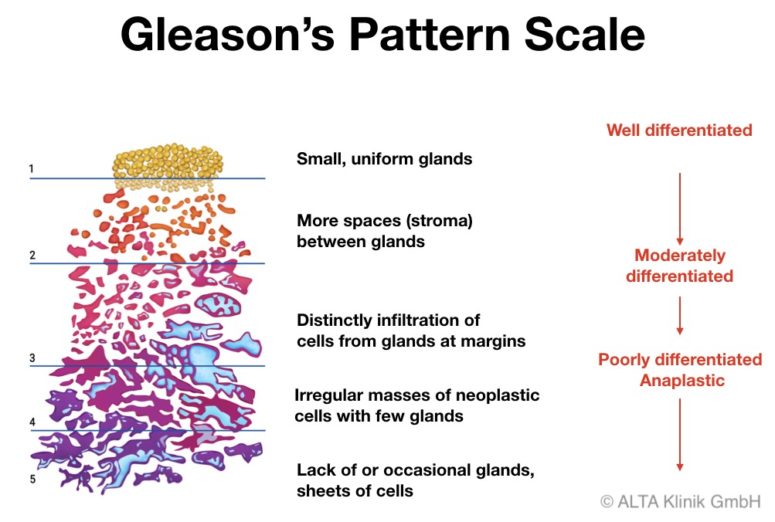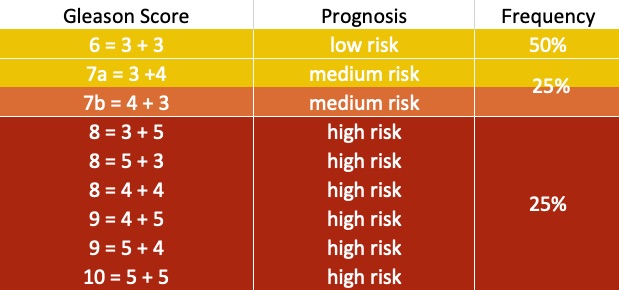Gleason Score
The Degree of a Tumor’s Malignancy
The Gleason Grading System
The Gleason grading system is an internationally recognized system of ascertaining the degree of a prostate tumor’s malignancy. A Gleason score indicates the extent to which the appearance of a sample of prostate tumor cells departs from that of healthy cells in the prostate.
The highest Gleason score is 10 (5+5) and the lowest is 2 (1+1). Gleason scores ranging from 2 (1+1) to 5 (3+2) are regarded as unremarkable. This is because tumors only qualify as malignant if they have a Gleason score of 6 (3+3) or higher.
Generally speaking, the higher Gleason score, the more malignant the tumor.
Gleason Score Composition
The primary grade in the composite Gleason score corresponds to the dominant cell pattern found in the tumor. The secondary grade in the composite Gleason score corresponds to the next-most frequent cell pattern found in the tumor. The grades may be identical, as in the case of a Gleason score of 6 (3+3), or different, as in the case of a Gleason score of 7 (4+3). Non-identical numbers indicate that the tumor does not have a homogeneous composition and exhibits varying cell patterns.

A grade of 5 corresponds to a highly aggressive or malignant cell pattern. In contrast, while a grade of 3 is also regarded as malignant, it does not have an aggressive pattern. Depending on their frequency, cells with a Gleason score of 4 may tend toward tumors with a Gleason score of 6 (in the case of 3+4) or 8 (in the case of 4+3). That is why tumors with a Gleason score of 7 are regarded as intermediate-grade tumors.
The Most Common Degree of Malignancy
Statistically, most prostate tumors are assigned a Gleason score of 6 and qualify as low-grade or low-risk. Around 50% of all men who are diagnosed with prostate cancer have a tumor in this malignancy range.
Tumors assigned a Gleason score of 7 (3+4 or 4+3) qualify as intermediate-grade (or moderately aggressive) and account for around 25% of all men diagnosed with prostate cancer.
Tumors that have been assigned a Gleason score of 8 (4+4), 9 (4+5 or 5+4) and 10 (5+5) are regarded as highly aggressive and account for around 25% of all men diagnosed with prostate cancer.
Recording of Gleason Scores
If prostate cancer is diagnosed on the basis of a biopsy, the pathologist who examined the tissue sample will assign the sample a Gleason score.
Prostate tissue is also examined by a pathologist after every prostatectomy, and the tissue is again assigned a Gleason score on the basis of the cell patterns found. This information is generally available in the surgery report and in the pathology report.
 English
English
 Deutsch
Deutsch  Nederlands
Nederlands 






